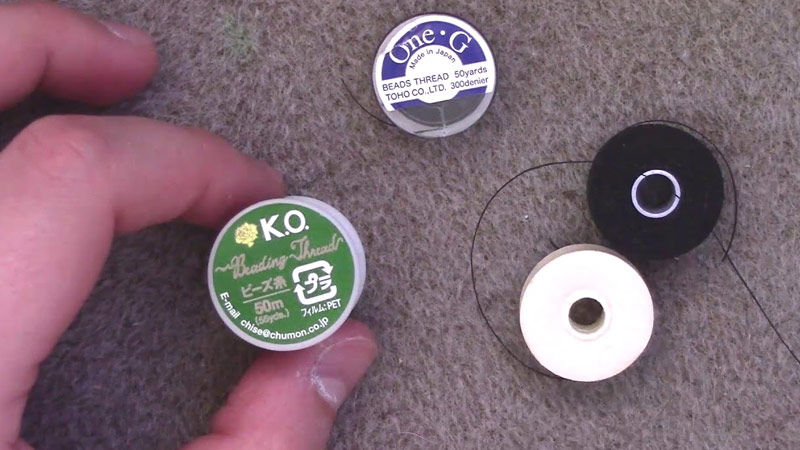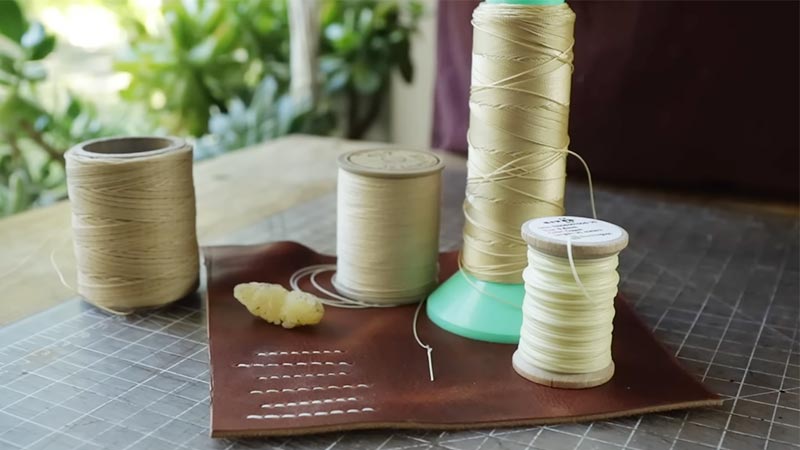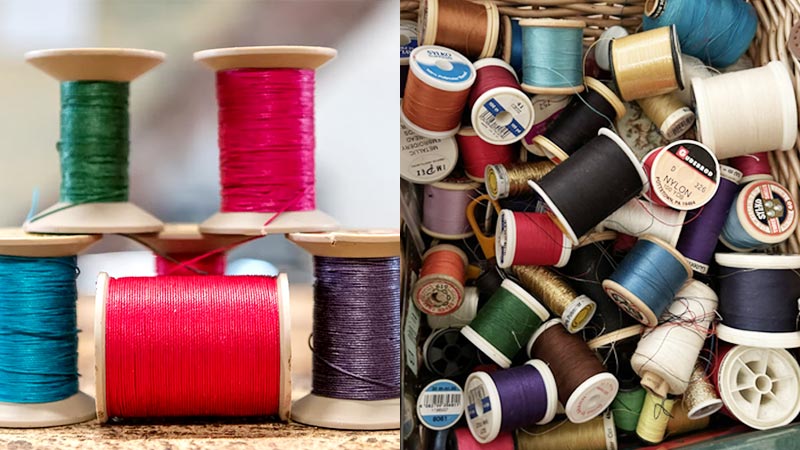Crafters and artisans, whether working on intricate beadwork or stitching fabrics together, understand the crucial role that thread plays in their creative endeavors. Two common threads often found in the crafting universe are Nymo and sewing thread.
These threads, while similar in their thread-based nature, diverge significantly in their composition, strengths, and intended uses. In this exploration, we delve into the world of Nymo and sewing thread, unraveling their shared commonalities and distinctive differences.
This journey will help you understand when to reach for Nymo and when to opt for sewing thread, ensuring that your crafting projects are stitched together with precision and creativity.

Is Nymo Similar To Sewing Thread?
Nymo and sewing thread serve as essential materials in the world of crafting, but they diverge in their primary purposes and characteristics. Nymo, a specialized nylon thread coated with wax, finds its niche in beadwork.
Renowned for its strength, flexibility, and a vast array of colors, Nymo excels at securely holding beads in intricate patterns, from jewelry to bead embroidery.
In contrast, sewing thread, available in various materials like cotton, polyester, and silk, serves as the backbone of fabric-related projects, from clothing construction to quilting.
While both offer color diversity, Nymo’s durability, and flexibility make it the preferred choice for intricate beadwork, whereas sewing thread finds its forte in stitching fabrics.
What Is Nymo Thread?

Nymo thread is a specialized nylon thread widely used in beadwork and jewelry-making. It is composed of multiple strands of nylon lightly twisted together and coated with wax.
This unique composition provides Nymo with exceptional strength, flexibility, and resistance to fraying. Available in various sizes and an extensive range of colors, Nymo thread is tailored for intricate bead designs, from beaded jewelry to embroidery and embellishing accessories.
Crafters value Nymo for its durability, pliability, and ability to securely hold beads in place, making it an indispensable tool for creating intricate and long-lasting beadwork projects.
What Is Sewing Thread?
Sewing thread is a slender strand of material, commonly made from cotton, polyester, silk, rayon, or blends of these fibers, used in various crafting applications. It serves as the essential component for connecting, mending, and securing pieces of fabric or textiles.
Sewing thread is fundamental in garment construction, quilting, upholstery, and general textile-related projects. It offers a wide range of colors and thicknesses to suit different fabric types and sewing tasks.
Its versatility makes it a staple in the world of crafting, ensuring the structural integrity and aesthetic appeal of stitched items, from clothing and home decor to repairs and creative projects.
What Common Threads Connect Nymo and Sewing Thread in Crafting?

In the intricate world of crafting, threads play a vital role, in weaving creative visions into reality. Nymo and sewing thread, despite their unique applications, share commonalities that unite them as indispensable tools for crafters.
Let’s unravel the threads that connect these two seemingly distinct types of threads in the crafting universe:
Thread-Based Foundations
At the heart of both Nymo and sewing thread lies their thread-based nature. These slender strands, though designed for different purposes, serve as the backbone of countless crafting projects, offering strength and structure to creative endeavors.
A Palette of Colors
One striking commonality between Nymo and sewing thread is the abundance of colors they provide. Both threads offer a diverse array of shades, allowing crafters to infuse their projects with personal style and creativity.
Whether it’s beadwork or sewing, color coordination is a powerful artistic tool.
Essential Crafting Tools
Nymo and sewing thread, while distinct in their primary uses, share the distinction of being essential crafting tools. Nymo excels in securing beads in intricate designs, while sewing thread is the cornerstone of fabric-based projects.
They are the threads that tie together crafting endeavors.
Versatility Beyond Boundaries
Although Nymo and sewing thread are tailored for specific crafting tasks, they offer a degree of versatility. Nymo, primarily designed for beadwork, can occasionally lend its decorative touch to fabric projects.
Conversely, sewing thread, often associated with fabrics, might find its way into creative bead embellishments.
Freedom for Artistic Expression
Both threads provide crafters with a canvas for artistic expression. Nymo, with its strength and flexibility, allows for intricate bead designs, enabling the creation of patterns and curves. Sewing thread, a symbol of reliability, ensures beautiful and lasting stitches in fabric projects.
Expansive Creativity
Nymo and sewing thread open doors to boundless creativity. Their shared thread-based nature and the kaleidoscope of colors they offer enable crafters to blend different techniques, adding touches of beadwork to fabric or sewing threads to bead designs.
What Are the Key Differences Between Nymo and Sewing Thread in Crafting?

In the diverse landscape of crafting, the choice of thread can significantly impact the outcome of a project. Nymo and sewing thread, both valuable in their own right, are designed for distinct purposes.
Understanding the key differences between these threads is essential for crafting success. Let’s explore the fundamental distinctions:
Purpose
- Nymo: Nymo is purpose-built for beadwork. It is specifically designed to secure beads in intricate designs and to withstand the unique demands of this craft.
- Sewing Thread: Sewing thread, on the other hand, is a versatile thread designed for general sewing tasks on fabrics, from stitching seams to creating hems.
Strength
- Nymo: Nymo is celebrated for its exceptional strength. It can handle the weight of beads and the tension created during intricate beadwork, ensuring the longevity of the project.
- Sewing Thread: While sewing thread can be strong, it may not match the durability of Nymo, especially when exposed to the unique stresses of beadwork, such as abrasive beads or metal findings.
Flexibility
- Nymo: Nymo offers a high degree of flexibility and pliability, making it ideal for intricate patterns, curves, and shapes in beadwork without compromising the thread’s integrity.
- Sewing Thread: Sewing thread, especially when composed of synthetic fibers, can be stiffer and less flexible. This rigidity may not be suitable for delicate and intricate work often required in beadwork projects.
Thickness
- Nymo: Nymo provides a broader range of sizes, from the thinnest (e.g., size 00) to the thickest (e.g., size F). This versatility allows crafters to choose the right thickness to match various bead sizes and project intricacies.
- Sewing Thread: Sewing thread typically offers a narrower range of thickness options. This limitation can affect its suitability for projects with varied bead sizes and hole dimensions.
How Should Crafters Choose Between Nymo and Sewing Thread Based on Project Requirements?
The success of any crafting project is often determined by the choice of thread. Nymo and sewing thread, while both valuable in their own right, serve distinct purposes in the crafting world.
To make an informed decision when selecting between Nymo and sewing thread, it’s essential to consider your project’s specific requirements.
Here’s a guide on how crafters should make the right choice:
Project Type
- Nymo: Choose Nymo when working on bead-related projects, such as making jewelry, bead embroidery, or crafts that involve beads. Nymo’s strength and flexibility are tailored to meet the unique demands of beadwork.
- Sewing Thread: Opt for sewing thread when your project involves general sewing tasks on fabrics, including garment construction, repairs, quilting, and various textile-related projects.
Beadwork Intensity
- Nymo: If your project features intricate or heavy beadwork, Nymo is the ideal choice. Its exceptional strength ensures that it securely holds the beads in place, guaranteeing long-lasting results.
- Sewing Thread: Consider using sewing thread when the beadwork is minimal or decorative. For projects that involve a few beads added to clothing or home decor items, sewing thread can serve the purpose efficiently.
Flexibility and Delicacy
- Nymo: When your project demands delicate and intricate designs with beads, Nymo’s flexibility and pliability are essential. It enables you to create detailed patterns, curves, and shapes with ease.
- Sewing Thread: For straightforward sewing tasks on fabrics, where flexibility is not the primary concern, sewing thread will be sufficient.
Color Matching
- Nymo: Nymo offers a wide range of color options, making it an excellent choice for beadwork projects that require precise color matching with the beads used.
- Sewing Thread: While sewing thread comes in various colors, it may not provide the same level of color accuracy as Nymo. If color matching is a crucial aspect of your project, Nymo might be the better option.
Thickness and Bead Size
- Nymo: Nymo offers a broader range of thickness options, allowing you to select the right size to match the bead hole size and design intricacy.
- Sewing Thread: Sewing thread’s thickness options may not provide the same versatility for beadwork. Therefore, consider Nymo for projects with varied bead sizes and hole dimensions.
FAQs
Is Nymo thread more expensive than sewing thread?
Nymo thread is often priced slightly higher than sewing thread due to its specialized composition and suitability for beadwork. Sewing thread, being more common, is generally more budget-friendly.
Can I combine Nymo and sewing thread in the same project?
Combining Nymo and sewing thread can be a creative choice for mixed-media projects. Just ensure that you select the right thread for its intended purpose within the project.
Are there specific types of beads that work better with Nymo or sewing thread?
Nymo is well-suited for various bead types, especially delicate or heavy beads. Sewing thread is typically more versatile and can be used with a wide range of beads.
Can Nymo or sewing thread be used for embroidery projects?
While Nymo is suitable for bead embroidery, it may not be the best choice for traditional embroidery on fabrics. Sewing thread, particularly embroidery thread, is tailored for this purpose.
Are there any special tips for storing Nymo and sewing thread to maintain their quality?
Both Nymo and sewing thread should be stored in a cool, dry place away from direct sunlight to prevent damage. Consider using thread organizers to keep them tangle-free.
To Recap
In the tapestry of crafting, the threads of Nymo and sewing thread may appear similar at a glance, yet they possess distinct and complementary qualities.
Nymo, designed for intricate beadwork, offers unparalleled strength, flexibility, and a spectrum of colors, making it the ideal companion for securing beads in artistic patterns.
In contrast, sewing thread, a versatile seamstress’s tool, finds its strength in the world of fabrics, making garments and textiles come to life with stitches that stand the test of time.
While Nymo and sewing thread serve different crafting realms, they share common threads of creativity, offering crafters an array of choices to weave their artistic visions with precision and finesse.
Leave a Reply